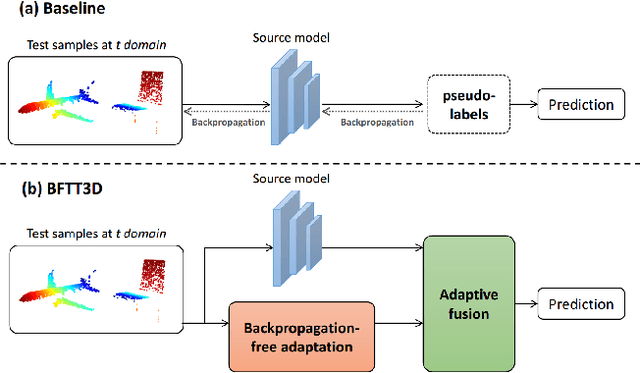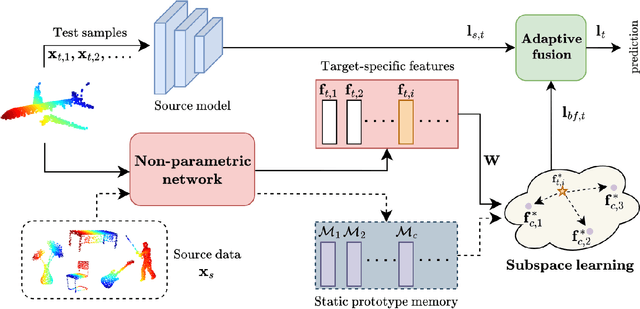Yanshuo Wang
Maintain Plasticity in Long-timescale Continual Test-time Adaptation
Dec 28, 2024



Abstract:Continual test-time domain adaptation (CTTA) aims to adjust pre-trained source models to perform well over time across non-stationary target environments. While previous methods have made considerable efforts to optimize the adaptation process, a crucial question remains: can the model adapt to continually-changing environments with preserved plasticity over a long time? The plasticity refers to the model's capability to adjust predictions in response to non-stationary environments continually. In this work, we explore plasticity, this essential but often overlooked aspect of continual adaptation to facilitate more sustained adaptation in the long run. First, we observe that most CTTA methods experience a steady and consistent decline in plasticity during the long-timescale continual adaptation phase. Moreover, we find that the loss of plasticity is strongly associated with the change in label flip. Based on this correlation, we propose a simple yet effective policy, Adaptive Shrink-Restore (ASR), towards preserving the model's plasticity. In particular, ASR does the weight re-initialization by the adaptive intervals. The adaptive interval is determined based on the change in label flipping. Our method is validated on extensive CTTA benchmarks, achieving excellent performance.
Efficient Transfer Learning for Video-language Foundation Models
Nov 18, 2024



Abstract:Pre-trained vision-language models provide a robust foundation for efficient transfer learning across various downstream tasks. In the field of video action recognition, mainstream approaches often introduce additional parameter modules to capture temporal information. While the increased model capacity brought by these additional parameters helps better fit the video-specific inductive biases, existing methods require learning a large number of parameters and are prone to catastrophic forgetting of the original generalizable knowledge. In this paper, we propose a simple yet effective Multi-modal Spatio-Temporal Adapter (MSTA) to improve the alignment between representations in the text and vision branches, achieving a balance between general knowledge and task-specific knowledge. Furthermore, to mitigate over-fitting and enhance generalizability, we introduce a spatio-temporal description-guided consistency constraint. This constraint involves feeding template inputs (i.e., ``a video of $\{\textbf{cls}\}$'') into the trainable language branch, while LLM-generated spatio-temporal descriptions are input into the pre-trained language branch, enforcing consistency between the outputs of the two branches. This mechanism prevents over-fitting to downstream tasks and improves the distinguishability of the trainable branch within the spatio-temporal semantic space. We evaluate the effectiveness of our approach across four tasks: zero-shot transfer, few-shot learning, base-to-novel generalization, and fully-supervised learning. Compared to many state-of-the-art methods, our MSTA achieves outstanding performance across all evaluations, while using only 2-7\% of the trainable parameters in the original model. Code will be avaliable at https://github.com/chenhaoxing/ETL4Video.
Backpropagation-free Network for 3D Test-time Adaptation
Mar 27, 2024



Abstract:Real-world systems often encounter new data over time, which leads to experiencing target domain shifts. Existing Test-Time Adaptation (TTA) methods tend to apply computationally heavy and memory-intensive backpropagation-based approaches to handle this. Here, we propose a novel method that uses a backpropagation-free approach for TTA for the specific case of 3D data. Our model uses a two-stream architecture to maintain knowledge about the source domain as well as complementary target-domain-specific information. The backpropagation-free property of our model helps address the well-known forgetting problem and mitigates the error accumulation issue. The proposed method also eliminates the need for the usually noisy process of pseudo-labeling and reliance on costly self-supervised training. Moreover, our method leverages subspace learning, effectively reducing the distribution variance between the two domains. Furthermore, the source-domain-specific and the target-domain-specific streams are aligned using a novel entropy-based adaptive fusion strategy. Extensive experiments on popular benchmarks demonstrate the effectiveness of our method. The code will be available at https://github.com/abie-e/BFTT3D.
Continual Test-time Domain Adaptation via Dynamic Sample Selection
Oct 05, 2023



Abstract:The objective of Continual Test-time Domain Adaptation (CTDA) is to gradually adapt a pre-trained model to a sequence of target domains without accessing the source data. This paper proposes a Dynamic Sample Selection (DSS) method for CTDA. DSS consists of dynamic thresholding, positive learning, and negative learning processes. Traditionally, models learn from unlabeled unknown environment data and equally rely on all samples' pseudo-labels to update their parameters through self-training. However, noisy predictions exist in these pseudo-labels, so all samples are not equally trustworthy. Therefore, in our method, a dynamic thresholding module is first designed to select suspected low-quality from high-quality samples. The selected low-quality samples are more likely to be wrongly predicted. Therefore, we apply joint positive and negative learning on both high- and low-quality samples to reduce the risk of using wrong information. We conduct extensive experiments that demonstrate the effectiveness of our proposed method for CTDA in the image domain, outperforming the state-of-the-art results. Furthermore, our approach is also evaluated in the 3D point cloud domain, showcasing its versatility and potential for broader applicability.
 Add to Chrome
Add to Chrome Add to Firefox
Add to Firefox Add to Edge
Add to Edge